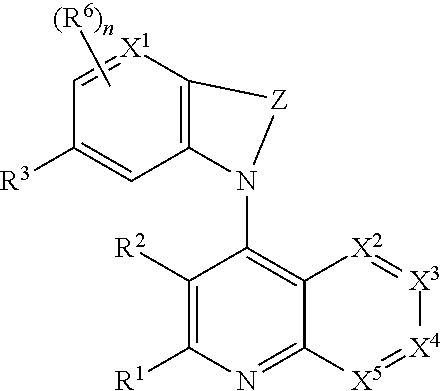Heterocyclic compounds and their uses
a technology of heterocyclic compounds and compounds, applied in the field of heterocyclic compounds and their, can solve the problems of limited utility of these compounds in studying the roles of individual class i pi 3-kinases, compounds, and non-specific pi3k inhibitors
- Summary
- Abstract
- Description
- Claims
- Application Information
AI Technical Summary
Benefits of technology
Problems solved by technology
Method used
Image
Examples
example 1
4-(3,3-Dimethyl-6-(4-morpholinyl)-2,3-dihydro-1H-indol-1-yl)-7-fluoro-3-methyl-2-(2-pyridinyl)quinoline
Ethyl 3-(3-fluorophenylamino)-2-methyl-3-oxopropanoate
[0192]
[0193]Prepared according to procedure A using 3-fluoroaniline (18 mL, 187 mmol), pyridine (31 mL, 374 mmol) and diethyl methylmalonate (48 mL, 281 mmol). The crude was purified by column chromatography on silica (using a gradient of hexane:EtOAc, 1:0 to 3:1 as eluent) to give ethyl 3-(3-fluorophenylamino)-2-methyl-3-oxopropanoate as a light brown solid. Mass Spectrum (ESI) m / e=240.1 (M+1).
3-(3-Fluorophenylamino)-2-methyl-3-oxopropanoic acid
[0194]
[0195]Prepared according to procedure B using ethyl 3-(3-fluorophenylamino)-2-methyl-3-oxopropanoate (21.0 g, 87.8 mmol) in THF (80 mL) to give 3-(3-fluorophenylamino)-2-methyl-3-oxopropanoic acid as a white solid. Mass Spectrum (ESI) m / e=212.1 (M+1).
7-Fluoro-3-methylquinoline-2,4-diol and 5-fluoro-3-methylquinoline-2,4-diol
[0196]
[0197]Prepared according to procedure C using 3-(3-f...
example 2
4-(3,3-Dimethyl-6-(4-morpholinyl)-2,3-dihydro-1H-indol-1-yl)-5-fluoro-3-methyl-2-(2-pyridinyl)quinoline
[0212]
[0213]Prepared according to procedure M using 3,3-dimethyl-6-morpholinoindoline (348 mg, 1496 μmol), 4-chloro-5-fluoro-3-methyl-2-(pyridin-2-yl)quinoline (340 mg, 1247 μmol) in DMF (12 mL), and sodium hydride (72 mg, 2992 μmol) and heating at 130° C. overnight. After purification 4-(3,3-dimethyl-6-(4-morpholinyl)-2,3-dihydro-1H-indol-1-yl)-5-fluoro-3-methyl-2-(2-pyridinyl)quinoline was obtained as a yellow film. 1H NMR (400 MHz, chloroform-d) δ ppm 8.76 (1H, dd, J=3.5, 1.2 Hz), 8.02 (1H, d, J=8.2 Hz), 7.83-7.96 (2H, m), 7.60 (1H, td, J=8.1, 5.3 Hz), 7.40 (1H, ddd, J=7.0, 5.1, 2.0 Hz), 7.08-7.17 (1H, m), 7.04 (1H, d, J=8.2 Hz), 6.26 (1H, dd, J=8.0, 2.2 Hz), 5.50 (1H, d, J=2.3 Hz), 3.76-3.85 (1H, m), 3.60-3.76 (5H, m), 2.86-3.02 (4H, m), 2.42 (3H, s), 1.50 (3H, s), 1.44 (3H, s). Mass Spectrum (ESI) m / e=469 (M+1).
example 3
1-(7-fluoro-3-methyl-2-(2-pyridinyl)-4-quinolinyl)-6-(4-morpholinyl)-1,2,2′,3′,5′,6′-hexahydrospiro[indole-3,4′-pyran]
Dimethyl 2-(4-bromo-2-nitrophenyl)malonate
[0214]
[0215]Prepared according to procedure G using potassium carbonate (94.23 g, 681.8 mmol), dimethyl malonate (39.1 mL, 340.9 mmol) and 4-bromo-1-fluoro-2-nitrobenzene (28 mL, 227.27 mmol) in DMF (227 mL). After pouring over 200 mL of 2N aqueous HCl the precipitate was collected by filtration and washed with water (4 L) to give dimethyl 2-(4-bromo-2-nitrophenyl)malonate. Mass Spectrum (ESI) m / e=332 [(M+1) (79Br)] and 334 [(M+1) (81Br)].
Methyl 2-(4-bromo-2-nitrophenyl)acetate
[0216]
[0217]Prepared according to procedure H using dimethyl 2-(4-bromo-2-nitrophenyl)-malonate in DMSO (40 mL), LiCl (1.16 g, 27.4 mmol) and water (0.25 mL, 13.88 mmol) and heating at 100° C. for 15 h. After purification methyl 2-(4-bromo-2-nitrophenyl)acetate was obtained as an orange oil. Mass Spectrum (ESI) m / e=274 [(M+1) (79Br)] and 276 [(M+1) (81B...
PUM
 Login to View More
Login to View More Abstract
Description
Claims
Application Information
 Login to View More
Login to View More - R&D
- Intellectual Property
- Life Sciences
- Materials
- Tech Scout
- Unparalleled Data Quality
- Higher Quality Content
- 60% Fewer Hallucinations
Browse by: Latest US Patents, China's latest patents, Technical Efficacy Thesaurus, Application Domain, Technology Topic, Popular Technical Reports.
© 2025 PatSnap. All rights reserved.Legal|Privacy policy|Modern Slavery Act Transparency Statement|Sitemap|About US| Contact US: help@patsnap.com



